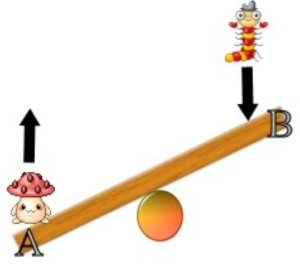Resistance to change decreases when you allow and hold it.
Resistance to change increases when you argue and push against it.
Resistance to Change – Consider the See Saw
Resistance to change is typically not a one-sided affair. The person who’s resisting also has unexpressed views about the positive side of change. As a leader or manager, you can bring out these positive feelings by doing the opposite of what comes most naturally. Don’t push against the resistance. Allow and hold it instead.
Case Study 1- Pushing Against Resistance
Several months ago Sam announced organization changes aimed at improving service quality and customer experience. As part of these changes, Sheryl, one of Sam’s direct reports, is taking on new responsibilities and her job title is changing. She perceives these changes as a demotion and a loss of status in the organization. Sam has noted Sheryl’s negative comments at meetings. He also sees her as avoiding assignments related to her new responsibilities.
Sam decides it’s time for The Talk. He meets with Sheryl and describes what he’s observed. Then asks what the problem is. Sheryl shares what she doesn’t like about her new role, including her title change. Sam, in turn, makes the case that these are positive changes. Sheryl replies with increased emotion and intensity regarding her sense of loss and the negative impact of these changes.
Each time Cheryl pushes her case for why this change is negative, Sam responds by pushing harder on his case for why the change is positive. After several rounds Sam realizes the conversation is at a stalemate and suggests that Sheryl take the weekend to think things over. To Sheryl this sounds like a thinly veiled threat, and indeed it is.
Sheryl and Sam are in the see saw of human dynamics that get us nowhere.

How to Get Off the See Saw
Human beings, that’s us, seek homeostasis, balance, stability. When I shift my position on the see saw, you respond by shifting your position to exactly the same degree. This allows us to keep our relationship to each other in perfect balance. Things are stable. We have achieved a state of homeostasis. This is how the push and pull of resistance works. When Sam increases his argument, Sheryl increases hers, until they are back to that state of perfectly balanced opposition to each other.
To end this particular cycle, Sam should push on Sherly’s side of the see saw, by empathizing with her. This doesn’t mean Sam is going to reverse his decisions. Empathy conveys understanding, not agreement.
When it comes to resistance,
“Seek first to understand, then to be understood.” Stephen Covey
Case Study 2 – Allowing and Holding Resistance
Tim inadvertently came across information that revealed his salary was much lower than his peers’, despite significant increases of late. Ed, Tim’s manager, had been doing what he could to resolve the salary problem. So, he was hurt and insulted when Tim revealed his deep disappointment in what he discovered. At first, Ed argued his case, describing the battles he fought to raise Tim’s salary. Tim pushed back, so did Ed. The see saw conversation ended in a stalemate of negative emotions. After Ed and I spoke about the see saw, he decided to try the Allow and Hold approach. Ed took Tim to lunch and shared his understanding of Tim’s disappointment. Then, Ed asked what Tim, “What would you like me to do differently?”
“I don’t need you to do anything,” Tim replied. “I just needed to know you understand.”

